Music 261 Final Exam
0.0(0)
0.0(0)
Card Sorting
1/96
Earn XP
Study Analytics
Name | Mastery | Learn | Test | Matching | Spaced |
|---|
No study sessions yet.
97 Terms
1
New cards
Thematic lessons focusing on integrating subject matter are more effective when topical rather than process oriented.
False
2
New cards
The most difficult of the integrated curricula to create is:
Immersion
3
New cards
Integration requires the same level of knowledge and skills as those needed for planing single discipline lesson plans:
False
4
New cards
The simplest and lowest level of integration is:
Connection
5
New cards
Potpourri, in lesson integration, refers to:
Losing focus and substance by random inclusion in lesson design
6
New cards
The most common structure of informal assessment and evaluation is:
Assessment by observation
7
New cards
Sequential lessons mean that activities should be:
Constructed to move from simple to more complex concepts
8
New cards
According to the text, the assessment and evaluation of students at the close of a lesson plan are:
Formal and informal
9
New cards
Objectives make lesson goals operation by stating specifically how a learner will demonstrate an understanding of the concept through observable behavior(s):
True
10
New cards
Educators develop the curriculum for their own classroom and the personal method or methods to achieve the goals.
True
11
New cards
“How many students have been to the circus?” is an example of:
A meaningful introductory statement
12
New cards
Duration is:
The length of time a sound lasts
13
New cards
A linear succession of pitches refers to:
Melody
14
New cards
Simultaneously occurring pitches refers to:
Harmony
15
New cards
Musical structure refers to:
Form
16
New cards
Which musical element refers to tone color?
Timbre
17
New cards
Form is found in all art forms
True
18
New cards
Which element of music contains pulse?
Rhythm
19
New cards
In which element of music do the pitches move up, down, or stay the same?
Melody
20
New cards
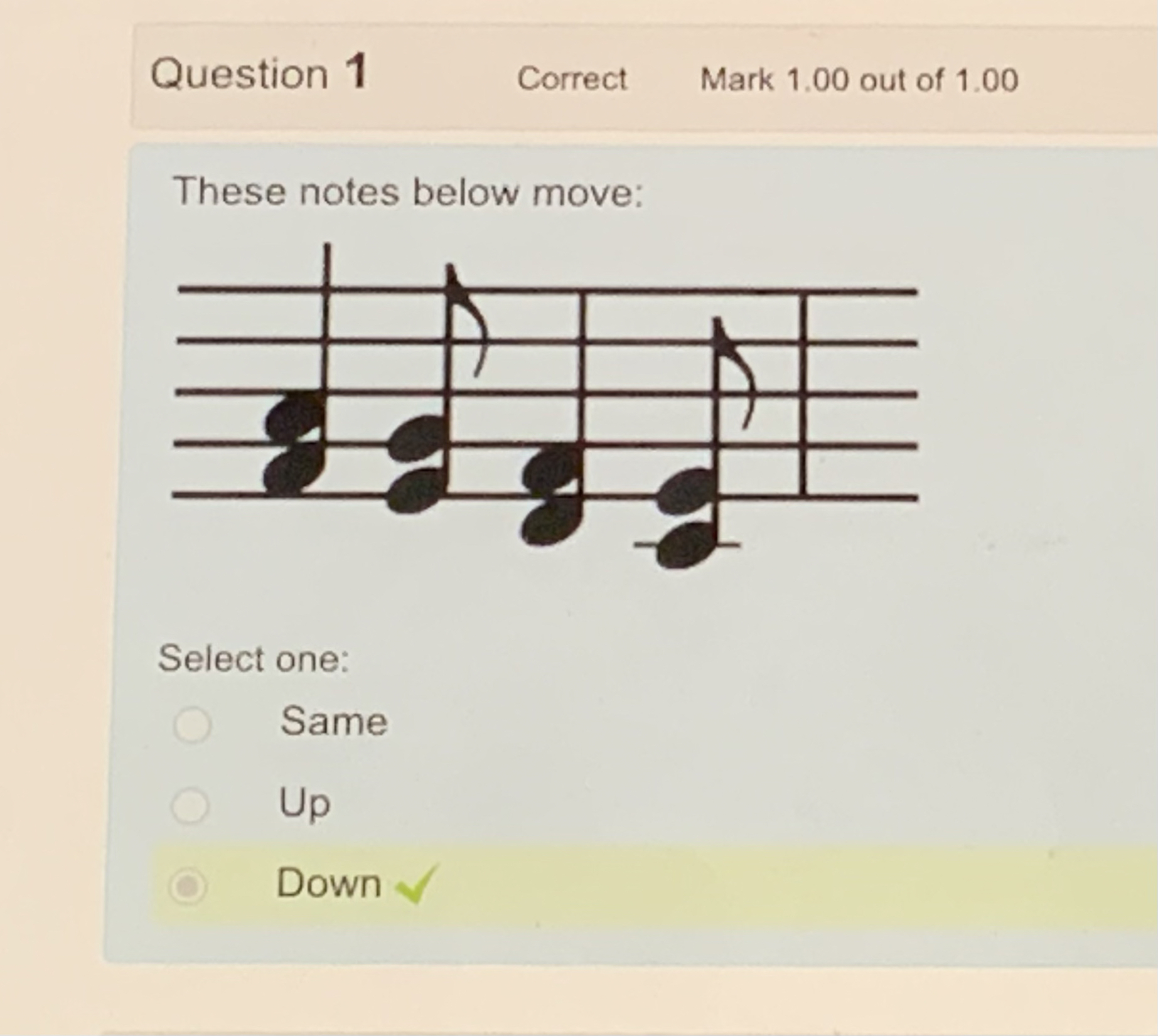
The notes below move:
Down
21
New cards
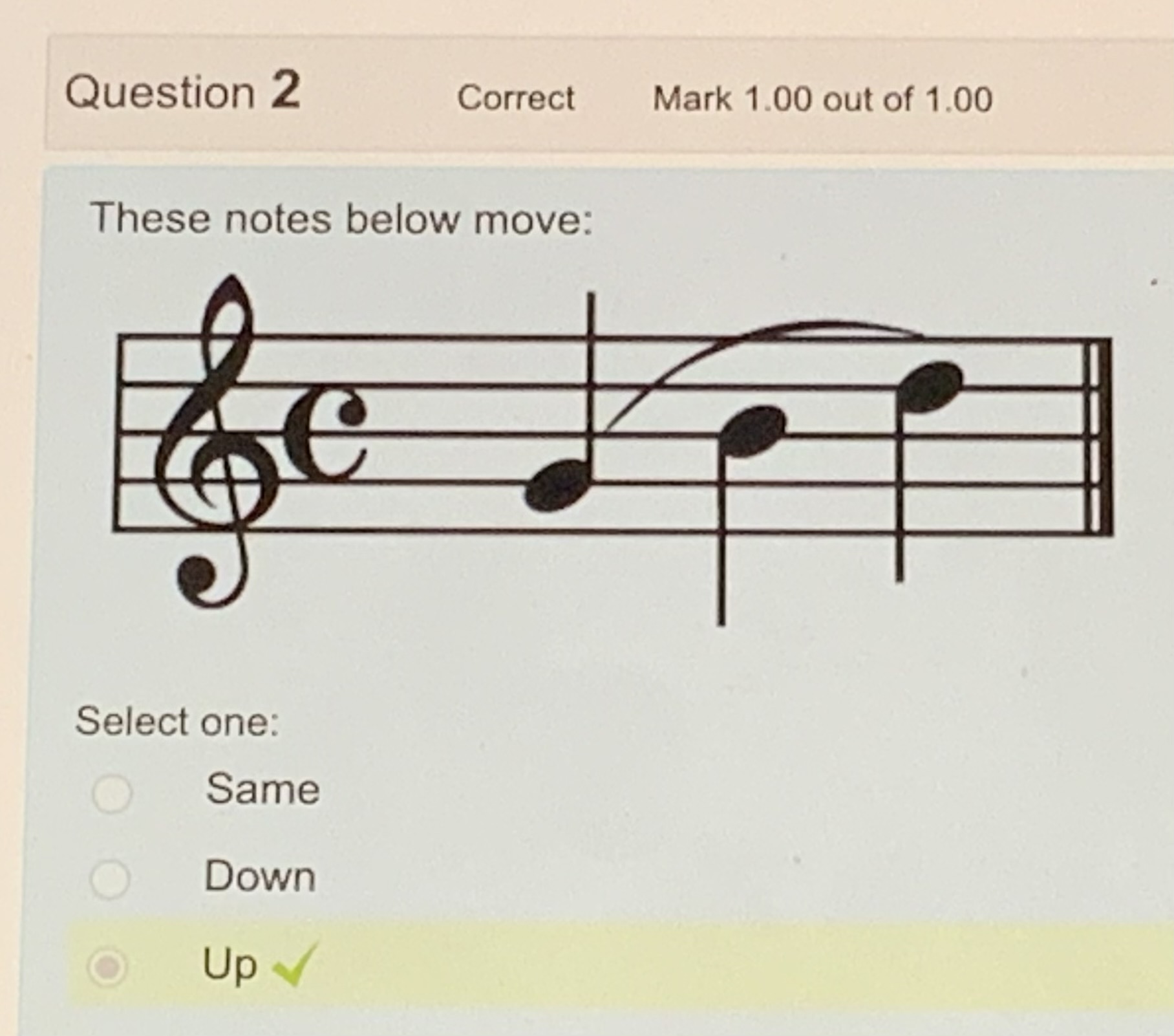
The notes below move:
Up
22
New cards
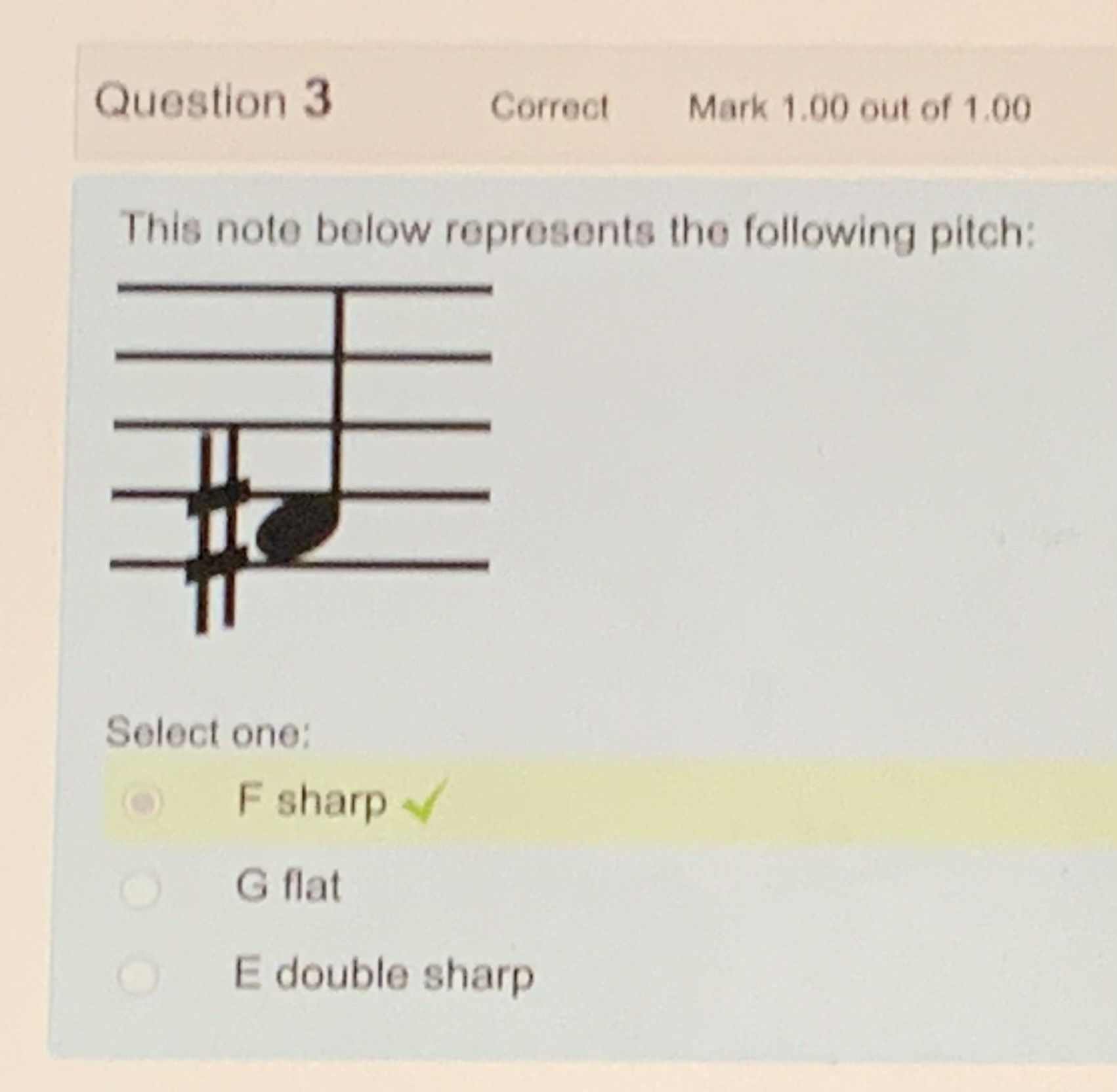
The note below represents the following pitch:
F sharp
23
New cards
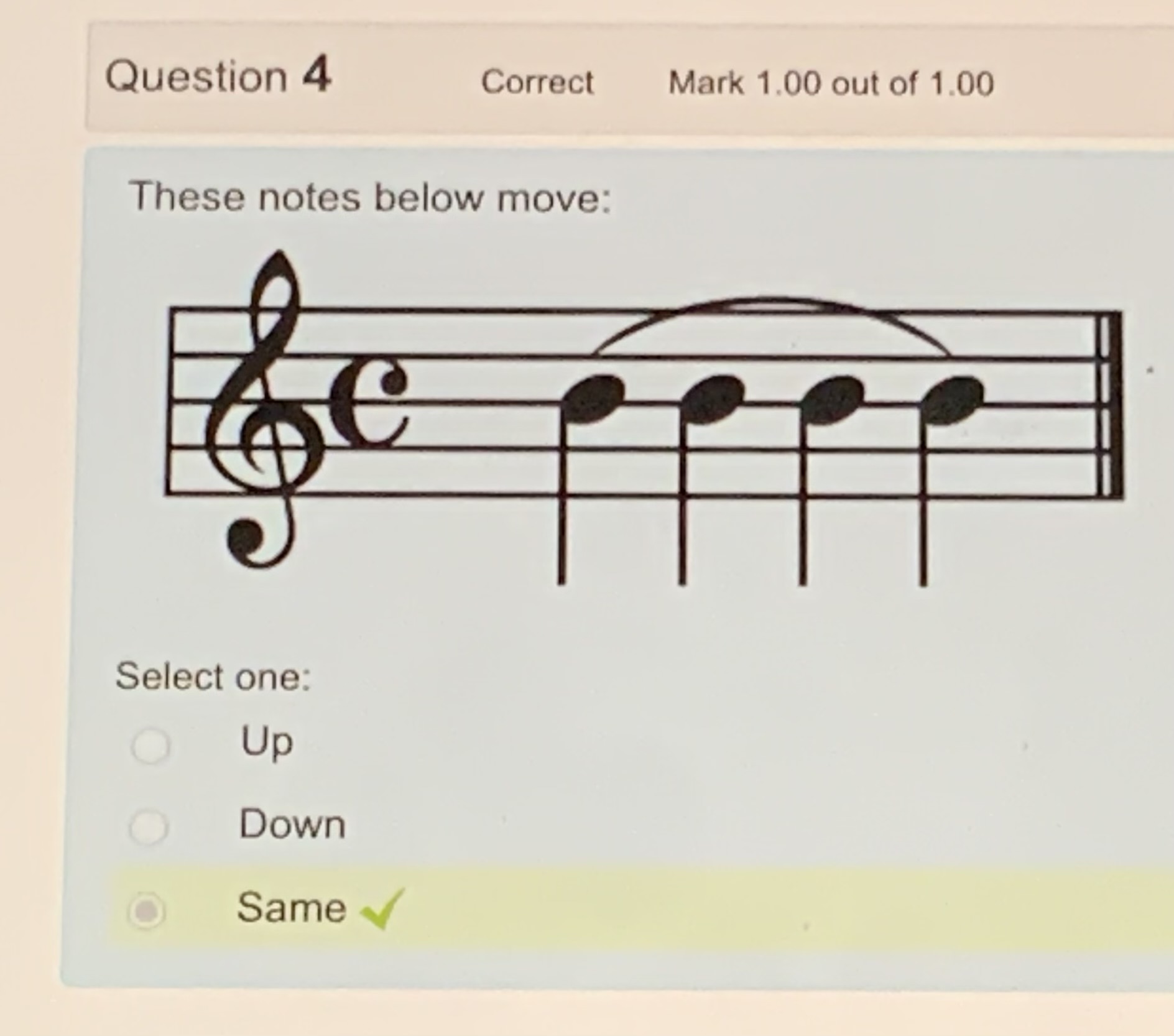
These notes below move:
Same
24
New cards
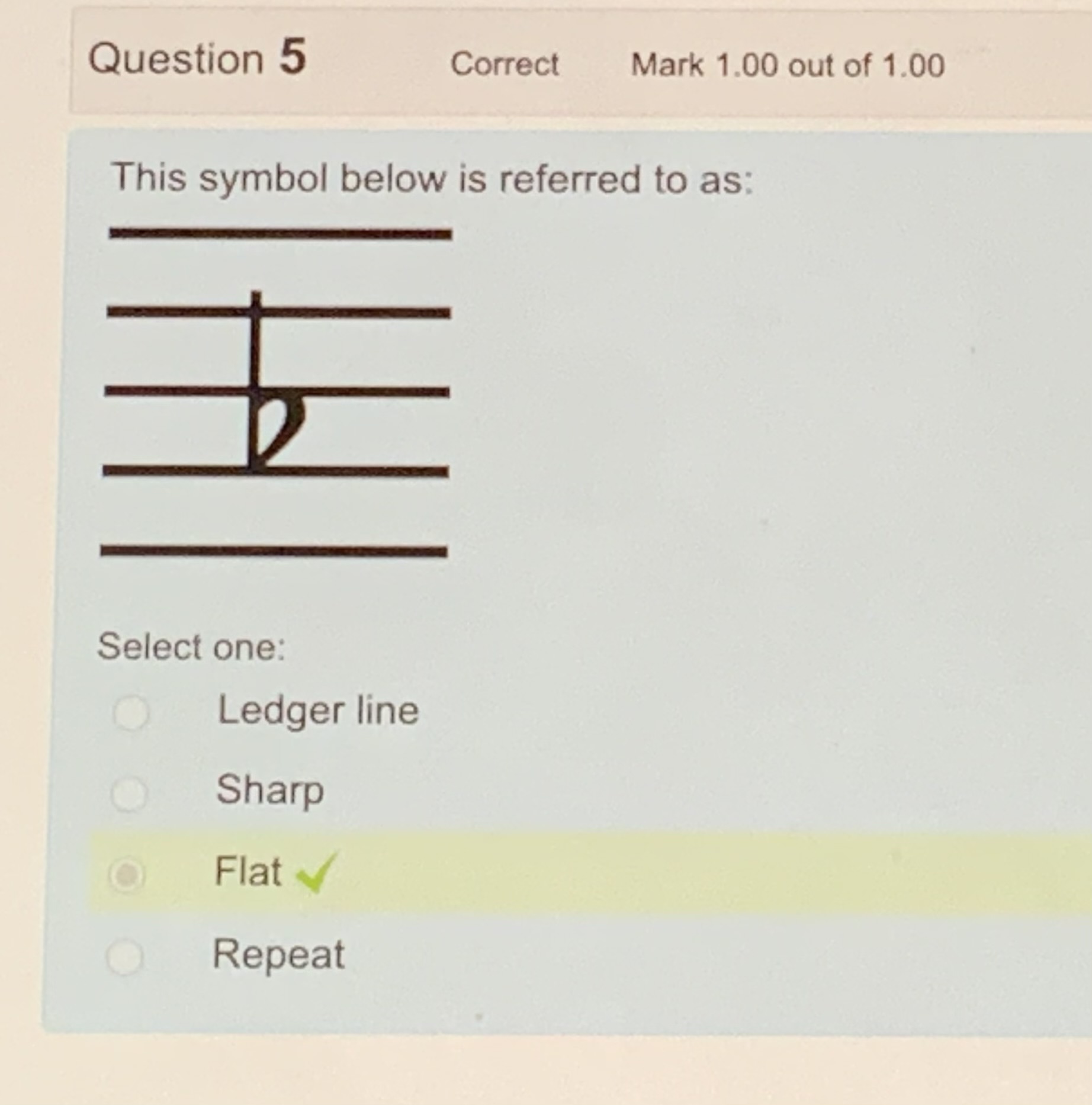
This symbol below is referred to as:
Flat
25
New cards
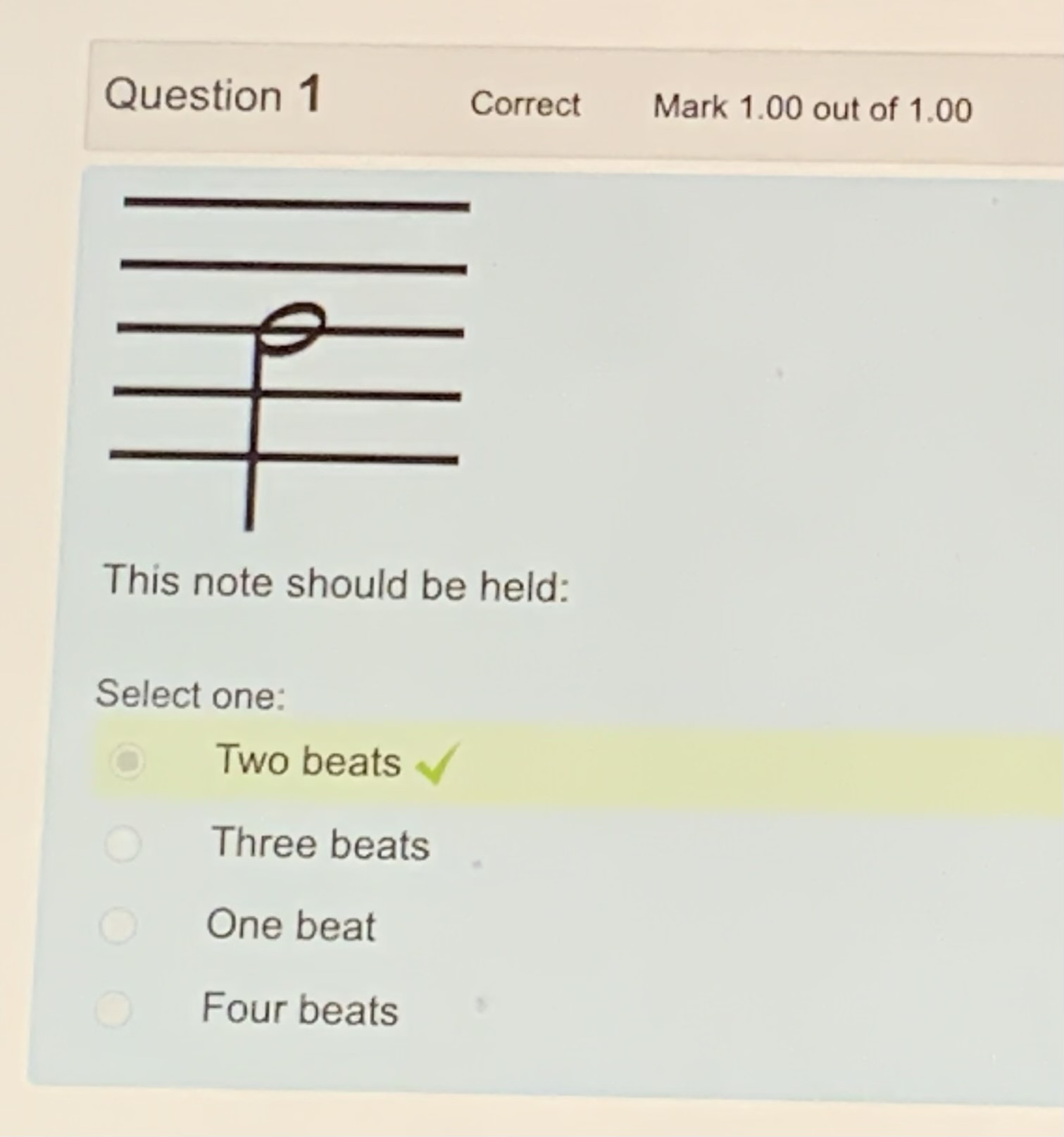
This note should be held:
Two beats
26
New cards
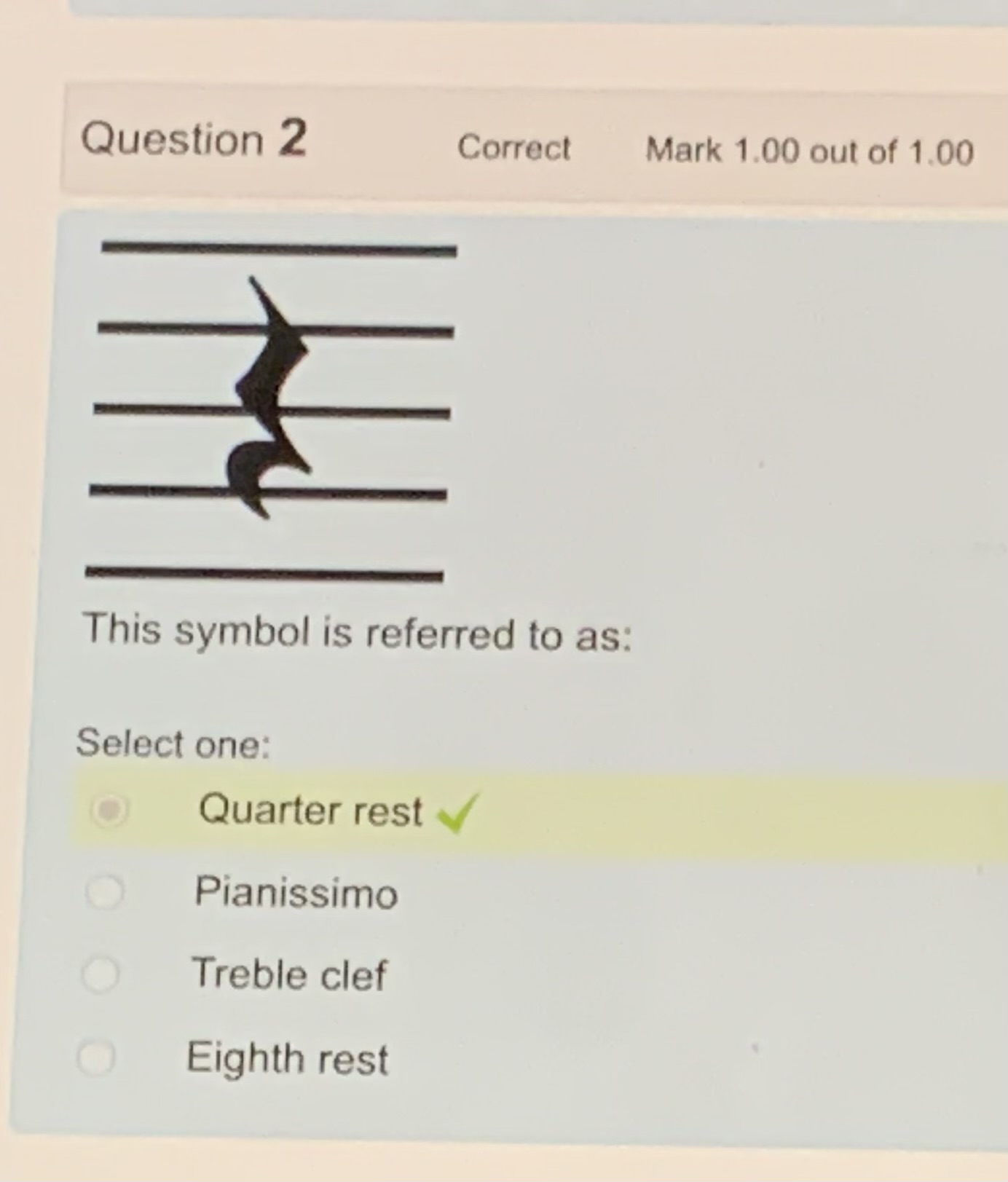
This symbol is referred to as:
Quarter rest
27
New cards
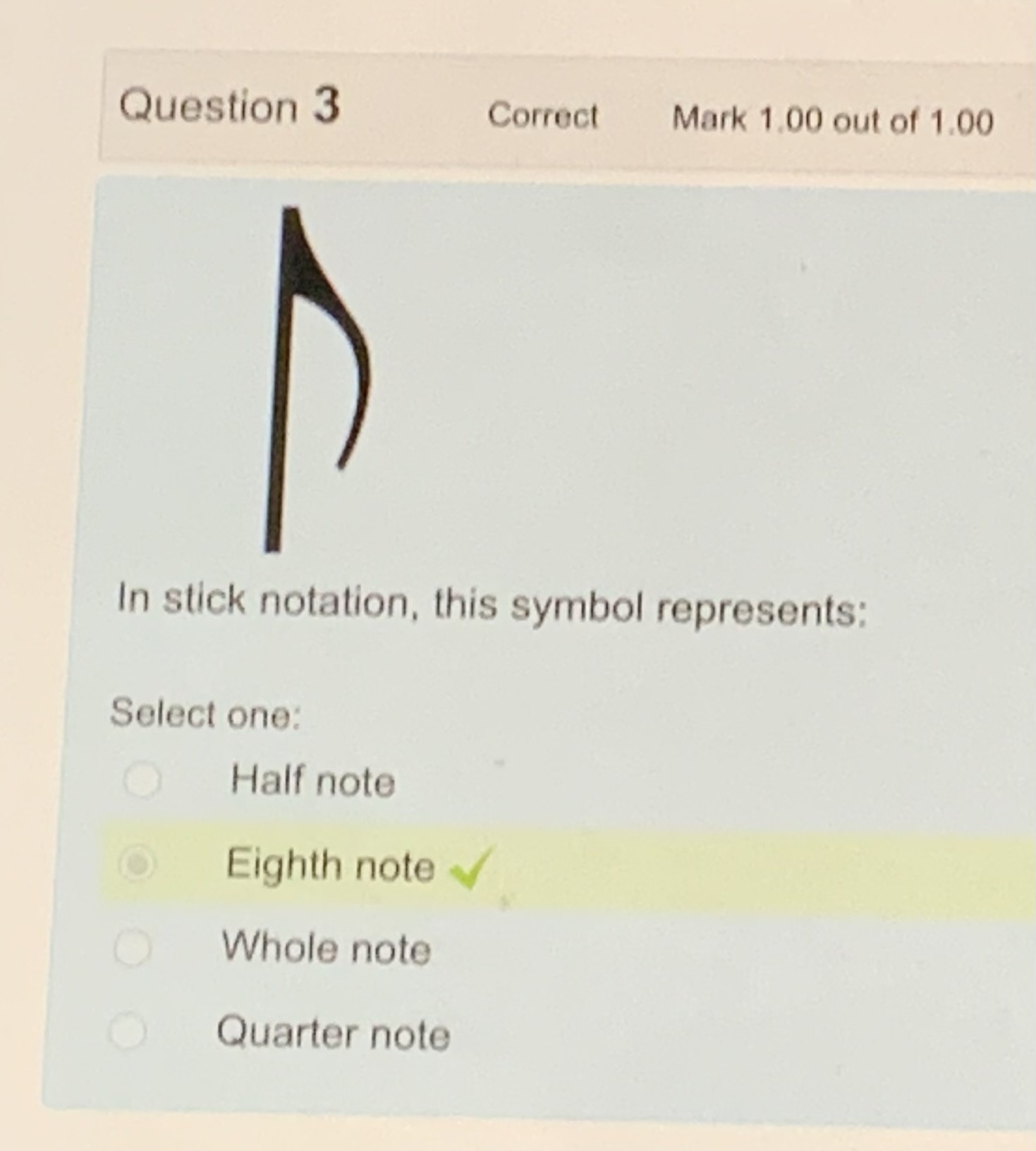
In stick notation, this symbol represents:
Eighth note
28
New cards
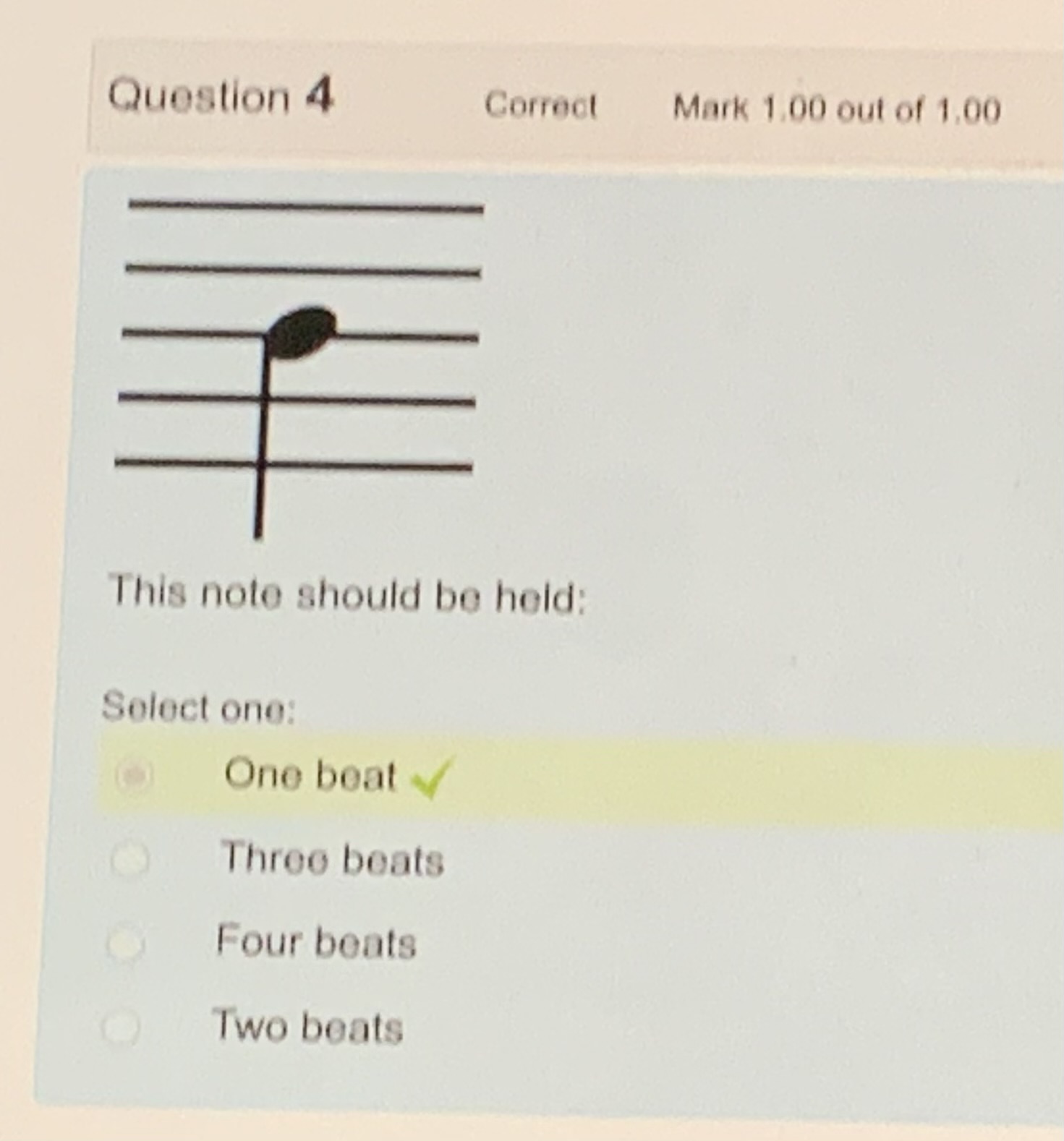
This note should be held:
One beat
29
New cards
The Alphabetic notation for Sol is:
G
30
New cards
A brief rhythmic and/or melodic figure or pattern that recurs throughout a composition as a unifying element is:
A motive
31
New cards
A form consisting of an original theme followed by a contrasting section, then the statement again, and a different contrasting section, and ending with the original theme is:
Rondo form
32
New cards
Tactile or concrete items used to help make abstract concepts tangible for students are referred to as:
Manipulatives
33
New cards
Students can be made aware of musical rhythm by:
Engaging language as a tool for learning duration and accent
34
New cards
The basic concepts of expression are:
Dynamics, articulation, and tempo
35
New cards
Which of the following is NOT an articulation directive?
Adagio
36
New cards
Two terms that suggest a manner or style of performance but do not affect a change in tempo are:
Cantabile and con fuoco
37
New cards
The melodic feature of same or different must be established first for students to illustrate the melodic contour of a piece of music.
True
38
New cards
The basic concepts of musical form are:
Contrast and repetition
39
New cards
The musician’s guide for an expressive performance is/are:
Musical notation
40
New cards
More than one melodic line performed at the same time is:
Polyphony
41
New cards
Songs with repeated music but different words are labeled as:
Strophic songs
42
New cards
Most children acquire a sense of beat:
Only as a result of repeated experiences
43
New cards
Which of the following is NOT a dynamic marking?
Giocoso
44
New cards
________ can be developed into ____________
Percepts - concepts
45
New cards
A melodic line performed with accompaniment is:
Homophony
46
New cards
Patsching is:
A form of body percussion
47
New cards
The type of dance activity that requires the highest degree of student skill and ability is:
Formal dance activities
48
New cards
An activity that pertains to bodily movement is:
Kinesthetic
49
New cards
Non-locomotor movement refers to:
Movement activities in which the student is stationary
50
New cards
Another term for action song is:
Play party games
51
New cards
Multi-sensory teaching means the teacher is:
All of these options - Using play party games to guide movement activities, using icons to introduce accent groupings, and using patsch to keep the beat
52
New cards
The following are elements that can be applied to elements in visual arts and music:
Contour, pattern, color
53
New cards
Iconography can be used to help make abstract concepts more concrete in visual arts and music.
True
54
New cards

The following images correspond or are representational of:
Contour

55
New cards
The relationship between music and visual arts is primarily visual.
False
56
New cards
Visual art and music stimulate exploration and provide ways that allow for self-directed experimentation.
True
57
New cards
Form is similar in both visual art and music in which of the following ways?
When sections are tied together or unified by an idea (a melody, a theme, a motive).
58
New cards
Onomatopoeic words can:
Suggest sounds that become music
59
New cards
Music compositions that are based on stories are referred to as:
Programmatic music
60
New cards
Chanting a rhythmic ostinato will help the student:
Develop an inner sense of rhythm
61
New cards
Musical beat or pulse is best represented through the following language arts form:
Poetry
62
New cards
Pulse in poetry and song is best reinforced by physical actions such as clapping or patsch.
True
63
New cards
Creativity is a direct means of student knowledge through skilled technical development of the musical elements.
False
64
New cards
The natural connection between the study of mathematics and music is:
Musical rhythm and musical notation
65
New cards
Music can be combined with the study of science through:
The construction of musical instruments
66
New cards
An important element to be considered when including multicultural music in instruction is the context of the music in the culture from which it comes.
True
67
New cards
If multicultural music is introduced into the elementary classroom the teacher should:
Concentrate on only one culture
68
New cards
An effective teaching strategy for integrating multicultural music in social studies lessons is to include students whose culture is represented in the classroom and/or community.
True
69
New cards
Modeling by the teacher is an important element in teaching multicultural music. Modeling techniques could include:
Listening to recordings and performances by multi-ethnic artists
70
New cards
Recordings are one of the most authentic means of enabling students to hear or see the performed music.
True
71
New cards
Which of the following is NOT appropriate when teaching a song using an accompaniment?
Having the entire class play accompaniment while they sing.
72
New cards
Which of the following is NOT an element to consider when selecting vocal literature for elementary grades?
Key Signature
73
New cards
The downbeat is:
The first accented beat of a song.
74
New cards
When teaching a song by rote, the teacher should:
Divide the song into short phrases and teach the song using an echo approach
75
New cards
When giving verbal cue, the teacher should:
Combine it with a visual cue
76
New cards
An anacrusis is:
The unaccented sounds preceding the first beat
77
New cards
When a song moves by skips and leaps, the melody is said to be:
Disjunct
78
New cards
After a slight pause following the giving of the starting pitch, the teacher should talk a gentle breath and:
Lift her head
79
New cards
Teaching by rote is also known as:
Lining out and echo teaching
80
New cards
A suitable activity for closure after singing a song would be to:
Review what was learned in the lesson and sing the song in its entirety
81
New cards
The term “chunking” refers to:
Dividing a song into phrases
82
New cards
The most appropriate range for a vocal selection for a kindergarten class would have the range from:
D above Middle C to A above middle C
83
New cards
Vocal warm-ups help young students to:
Relax and sing at different dynamic levels and learn to control the voice
84
New cards
The solfège hand sign system is an efficient method for:
Teaching inner hearing, teaching melodic direction, and teaching intervals
85
New cards
Animation means that the teacher is:
Changing his facial expressions
86
New cards
During the listening activity, the teacher is an active participant in the lesson by:
Maintaining frequent eye contact with the students and using facial expressions and body language that indicate enthusiasm
87
New cards
Limiting the students’ sensory input helps them to focus on their listening skills.
True
88
New cards
For a listening activity, the first time the students hear the selection:
The teacher should give specific guidelines for listening before the activity begins
89
New cards
If a listening activity has a second hearing, the activity for the second hearing should be identical to the activity for the first hearing.
False
90
New cards
Which of the following should be considered when planning a listening activity?
Integration of the activity into the students’ lives and experiences, teacher participation in the activity, and age-and-grade-appropriate selection
91
New cards
Stretching, bending, swaying, clapping, swinging, or bouncing are examples of:
Non-locomotor movements
92
New cards
Snapping, clapping, or swaying can be categorized as:
Abstract movements
93
New cards
Which of the following is NOT a best practice in teaching movement activities?
Use music that is the most familiar to students
94
New cards
In developing the body awareness that allows them to move freely in space, without inhibition, students should be involved in both locomotor and non-locomotor activities.
True
95
New cards
A student’s first introduction to movement activities should be:
Exploratory movement and musical experiences
96
New cards
Movement assists children to coordinate cognitive development in music.
True
97
New cards
Two types of creative movement are _____ and _________.
Free and dramatic